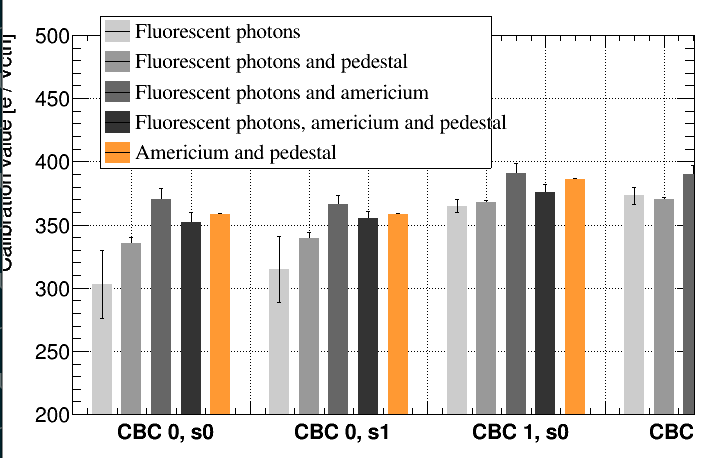_ROOT Version:6.14/08
_Platform:CentOS7 CERN
_Compiler:linuxx8664gcc
Hi Everyone,
I’m trying to make this plot below, but there are two problems I can’t solve.
First of all the error bars. For the most light grey bar in the plot they are on top and visible completely (which is what I want) but for the other bars they are only half way visible. I don’t know how to fix this.
The second problem I have is that the X axis is not long enough. I try to set it between 0 and 30 but that does not work. I tried different methods like SetRangeUser and SetMinimum and SetMaximum and SetLimits, but non of them give the full axes range.
Here is my code:
void makeFitComparePlots() {
// All data below is in the order c0s0, c0s1, c1s0, c1s1
const int combis = 4;
double fluo [combis] = {303., 315., 365., 373.};
double fluoErr [combis] = {27., 26., 5., 7.};
double fluoPed [combis] = {335., 339., 368., 370.};
double fluoPedErr [combis] = {5., 5., 1., 2.};
double fluoAm [combis] = {370., 366., 391., 390.};
double fluoAmErr [combis] = {9., 7., 8., 7.};
double fluoAmPed [combis] = {352., 355., 376., 377.};
double fluoAmPedErr [combis] = {8., 6., 6., 6.};
double amPed [combis] = {358., 358., 386., 386.};
double amPedErr [combis] = {1., 1., 1., 1.};
// First make the split per cbc/sensor
const int fitCombis = 5;
double binPos [fitCombis] = {1., 2., 3., 4., 5.};
double binPosErr [fitCombis] = {0., 0., 0., 0., 0.};
TGraphErrors *spl0 = new TGraphErrors;
TGraphErrors *spl1 = new TGraphErrors;
TGraphErrors *spl2 = new TGraphErrors;
TGraphErrors *spl3 = new TGraphErrors;
TGraphErrors *spl4 = new TGraphErrors;
for (int i=0; i<combis; i++){
spl0->SetPoint(i, 1+i*6, fluo[i]);
spl0->SetPointError(i, .0, fluoErr[i]);
spl1->SetPoint(i, 2+i*6, fluoPed[i]);
spl1->SetPointError(i, .0, fluoPedErr[i]);
spl2->SetPoint(i, 3+i*6, fluoAm[i]);
spl2->SetPointError(i, .0, fluoAmErr[i]);
spl3->SetPoint(i, 4+i*6, fluoAmPed[i]);
spl3->SetPointError(i, .0, fluoAmPedErr[i]);
spl4->SetPoint(i, 5+i*6, amPed[i]);
spl4->SetPointError(i, .0, amPedErr[i]);
}//end for i
TCanvas *c0 = allMyCanvasses(false, true);
TLegend *l0 = allMyLegends(51111);
gStyle->SetBarWidth(0.15);
spl0->GetXaxis()->SetRangeUser(0., 30.);
spl0->GetYaxis()->SetRangeUser(200., 500.);
spl1->GetXaxis()->SetRangeUser(0., 30.);
spl1->GetYaxis()->SetRangeUser(200. ,500.);
spl2->GetXaxis()->SetRangeUser(0., 30.);
spl2->GetYaxis()->SetRangeUser(200., 500.);
spl3->GetXaxis()->SetRangeUser(0., 30.);
spl3->GetYaxis()->SetRangeUser(200., 500.);
spl4->GetXaxis()->SetRangeUser(0., 30.);
spl4->GetYaxis()->SetRangeUser(200., 500.);
spl0->GetYaxis()->SetTitleSize(myFontSize);
spl0->GetYaxis()->SetLabelSize(myFontSize);
spl0->GetYaxis()->SetTitle("Calibration value [e / Vcth]");
spl0->GetXaxis()->SetLabelOffset(999);
spl0->SetFillColor(920);
spl0->Draw("ab");
spl1->SetFillColor(921);
spl1->Draw("sameb");
spl2->SetFillColor(922);
spl2->Draw("sameb");
spl3->SetFillColor(923);
spl3->Draw("sameb");
spl4->SetFillColor(oneColor);
spl4->Draw("sameb");
TText *tt0 = new TText(1.5, 180., "CBC 0, s0");
tt0->SetTextSize(myFontSize);
tt0->Draw();
TText *tt1 = new TText(7.5, 180., "CBC 0, s1");
tt1->SetTextSize(myFontSize);
tt1->Draw();
TText *tt2 = new TText(13.5, 180., "CBC 1, s0");
tt2->SetTextSize(myFontSize);
tt2->Draw();
TText *tt3 = new TText(19.5, 180., "CBC 1, s1");
tt3->SetTextSize(myFontSize);
tt3->Draw();
l0->AddEntry(spl0, "Fluorescent photons");
l0->AddEntry(spl1, "Fluorescent photons and pedestal");
l0->AddEntry(spl2, "Fluorescent photons and americium");
l0->AddEntry(spl3, "Fluorescent photons, americium and pedestal");
l0->AddEntry(spl4, "Americium and pedestal");
l0->Draw();
}//end void makeFitComparePlots()Can anyone find what I’m doing wrong here?
Cheers,
Nikkie

